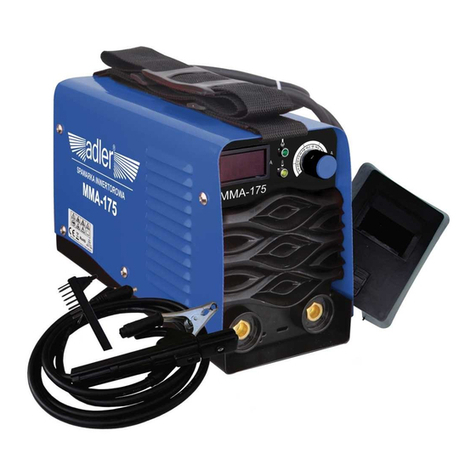
- Holding the mask IN FRONT OF THE FACE, strike the electrode tip on the workpiece as if you were striking a match.
This is the correct strike-up method.
- WARNING: do not hit the electrode on the workpiece, this could damage the electrode and make strike-up difficult.
- As soon as the arc is ignited, try to maintain a distance from the workpiece equal to the diameter of the electrode in
use. All the time keep this distance as even as possible. Remember that the angle of the electrode as it advances,
should be of 20-30 grades.
- At the end of the weld bead, bring the end of the electrode backward, in order to fill the weld crater, quickly lift the
electrode from the weld pool to extinguish the arc.
6.2 Scratch Strike TIG Welding
TIG welding is a welding procedure that exploits the heat produced by the electric arc that is struck, and maintained,
between a non-consumable electrode (tungsten) and the piece to be welded. The tungsten electrode is supported by
a torch suitable for transmitting the welding current to it and protecting the electrode itself and the weld pool from
atmospheric oxidation, by the flow of an inert gas (usually argon: Ar 99.5) which flows out of the ceramic nozzle.
- To achieve a good weld, the pieces should be carefully cleaned and free of oxidation, oil, grease, solvents etc.
- Always use the electrode with 2% cerium (grey band) and connect the TIG torch to negative (-) terminal.
- The electrode usually protrudes from the ceramic nozzle by 2-3mm, but this may reach 8mm for corner welding.
- make sure the electrode is sharpened and centered; then you will avoid any arc aberrations.
- To achieve a good weld it is absolutely necessary to use the exact electrode diameter with the exact current, see the
table:
6.2.1 Procedures
- Holding the mask IN FRONT OF THE FACE, strike the electrode tip on the workpiece as if you were striking a match.
- To stop welding, lift the electrode over welded object.
7. MAINTENANCE
WARNING! BEFORE CARRYING OUT MAINTENANCE OPERATIONS, MAKE SURE THE WELDING
MACHINE IS SWITCHED OFF AND DISCONNECTED FROM THE MAIN POWER SUPPLY.
7.1 EXTRAORDINARY MAINTENANCE MUST ONLY BE CARRIED OUT BY TECHNICIANS WHO ARE EXPERT OR
QUALIFIED IN THE ELECTRIC-MECHANICAL FIELD
- Checks inside the welding machine while it is on, may cause serious electric shock due to the direct contact with live
parts and/or injury due to direct contact with moving parts.
- Inspect the welding machine regularly, with a frequency depending on use and the dustiness of the environment, and
remove the dust deposited on the transformer, reactance and rectifier using a jet of dry compressed air (max. 10bar).
- Do not direct the jet of compressed air on the electronic boards; these can be cleaned with a very soft brush or
suitable solvents.
- At the same time make sure the electrical connections are tight and check the wiring for the insulation damage.
- At the end of these operations, re-assemble the panels of the welding machine and screw the fastening screws right
down.
- Never carry out welding operations while the welding machine is open.
- After having carried out maintenance or repairs, restore the connections and wiring as they were before, making sure
they do not come into contact with moving parts or parts that can reach high temperatures. Tie all the wires as they
were before, be careful to keep the high voltage connections of the primary transformer separate from the low voltage
ones of the secondary transformer.
Use original washers and screws when closing the casing.




























